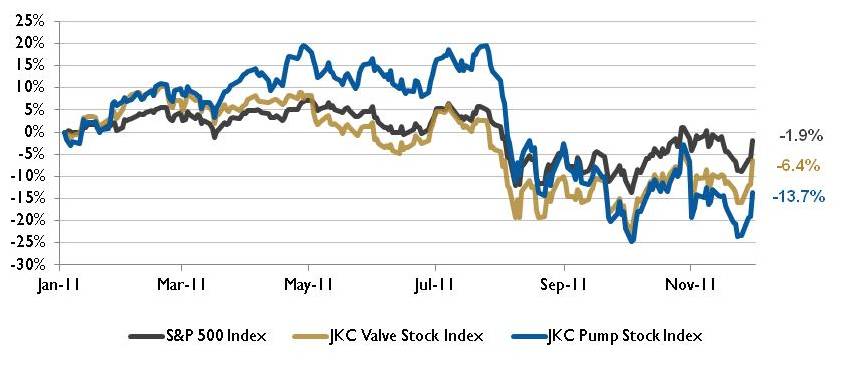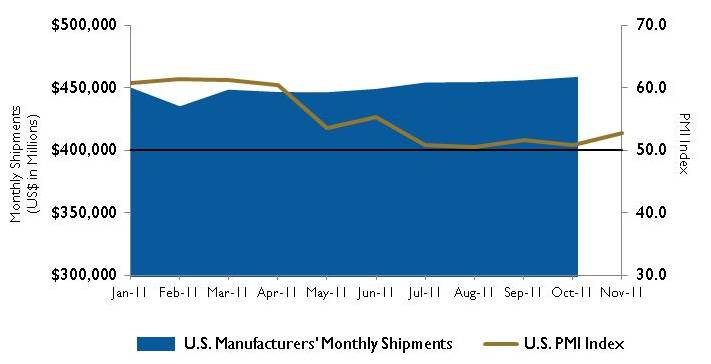Industry struggles to regain footing after recession
The Jordan, Knauff & Company (JKC) Valve Stock Index was down 6.4 percent during the first 11 months of 2011, below the broader S&P 500 Index, down 1.9 percent. The JKC Pump Stock Index was down 13.7 percent in the same time period.
Looking back at the U.S. economy in 2011, the fears about a double-dip recession became the realization that economic growth will remain sluggish for awhile. Moderate growth is the theme.
Figure 1. Stock Indices from January 1 to November 30, 2011 |
 |
Source: Capital IQ and JKC research. Local currency converted to USD using historical spot rates. The JKC Pump and Valve Stock Indices include a select list of publicly-traded compnaies involved in the pump and valve industries weighted by market capitalization. |
The U.S. GDP grew slowly in 2011. According to the Commerce Department, the economy expanded in the third quarter at a 2.0 percent growth rate. This is up from the 1.3 percent second quarter growth and the 0.4 first quarter percent growth. The gains in the third quarter reflected improved consumer spending, net exports and business investment. Government spending provided a negative contribution to growth, due to reduced federal, nondefense expenditures and continued declines in state and local spending. Many economists forecast a growth rate of between 2.5 and 3.0 percent for the last quarter of 2011. Data on consumption, business spending and residential investment point to growth, but still below the almost 4 percent late 2009 and the first half of 2010 growth.
The labor market struggled to gain back even a fraction of the jobs lost in the recession. Monthly gains averaged 130,000 jobs, much less than the 200,000 monthly average considered needed for robust economic growth. End-of-the-year hiring accelerated with the unemployment rate unexpectedly falling to 8.6 percent in November, its lowest rate in nearly three years.
Figure 2. U.S. Energy Consumption and Rig Counts |
 |
Source: U.S. Energy Information Administration and Baker Hughes, Inc. |
The Institute for Supply Management's Purchasing Managers Index (PMI) has shown consecutive monthly growth for more than two years. However, during the last few months of 2011, the PMI was near its lowest levels since mid-2009, after higher levels in early 2011. The Index rose in November to 52.7 from 50.8 in October. Growth in energy exploration and related inputs of steel and fabricated metals appear to be the cause.
According to the U.S. Energy Information Administration, the U.S. exported 753.4 million barrels of petroleum products made from crude oil in the first nine months of 2011, while it imported 689.4 million barrels, putting the nation on track to be a net exporter of gasoline, diesel and other oil-based fuels for the first time in 62 years. Booming demand from emerging markets and faltering domestic activity caused the U.S. to export more fuel than it imported. As recently as 2005, the U.S. imported nearly 900 million barrels more of petroleum products than it exported.
Figure 3. U.S. PMI Index and Manufacturing Shipments |
 |
Source: Institute for Supply Management Manufacturing Report on Business and U.S. Census Bureau |

